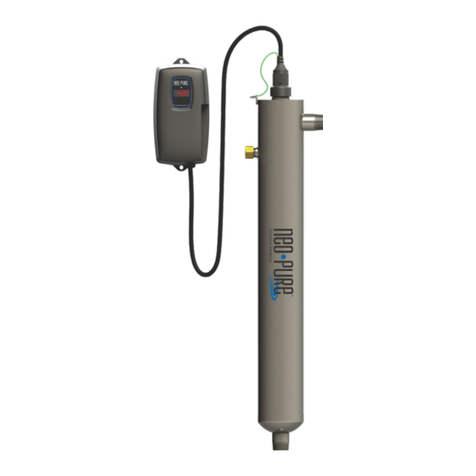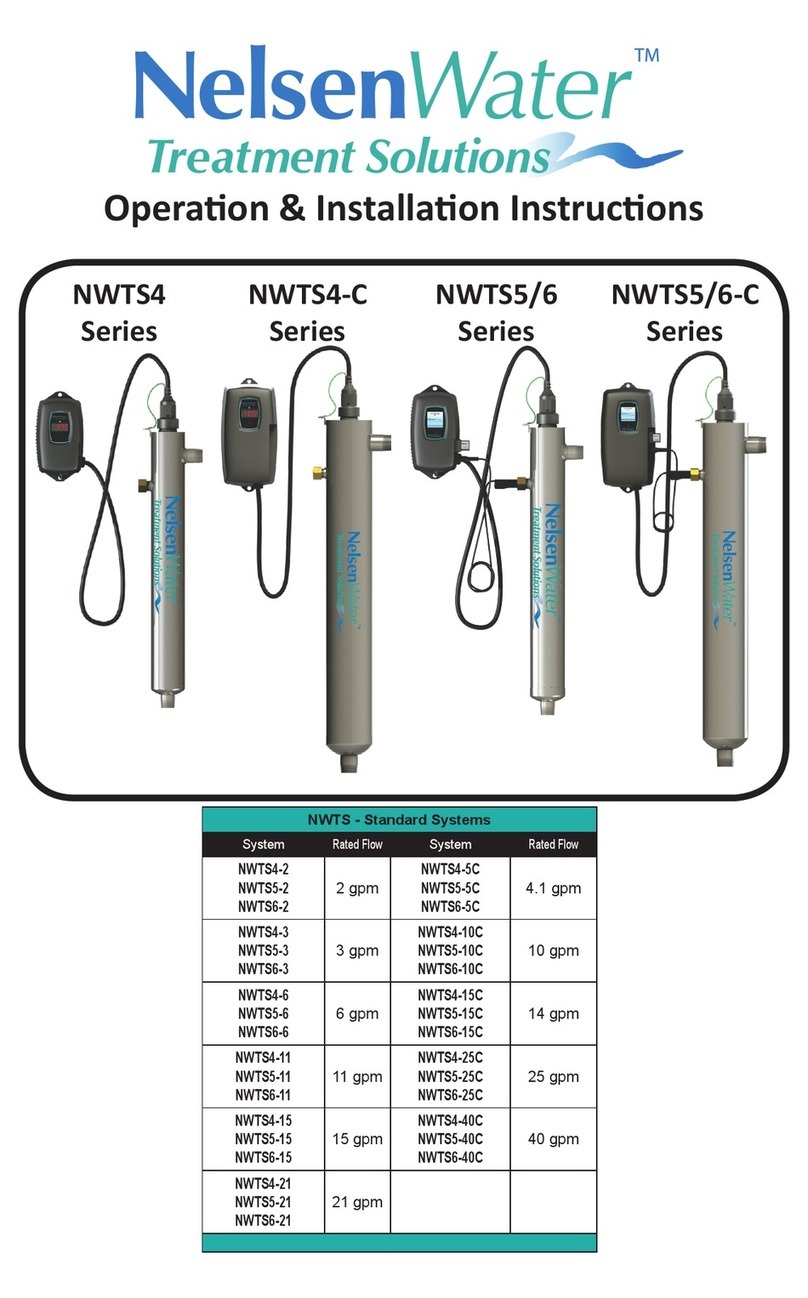
4
5. Initial tubing connections
For convenience on under counter installations it
may be advisable to complete under counter hose
connections at this time.
6. RO component installation
Install RO membrane, carbon pre filer and sediment
pre filter in modules of RO unit. (Refer to RO
installation diagram.)
7. RO unit installation
The RO unit is normally mounted to the right or left
sink cabinet sidewall, depending on where supply
tank is to be located. Generally the unit is installed
at the front of the cabinet and the tank at the rear.
To mount the unit, elevate it at least 2" off the floor,
level it and mark the location of mounting holes
needed. Drill holes for mounting screws and install
screws, allowing the mounting bracket slots to slip
over them.
Note: If the cabinet sidewalls are not solid, unit
may sit on the floor with screws to keep it against
the cabinet in a vertical position.
8. Pre-fill, sanitizing and supply tank placement
Prefilling the storage tank is always recommended
so there is sufficient pressure to check for leaks and
sufficient water to flush the carbon post filter.
It is important to use a sanitizer (such as Clorox) so
tubing, fittings, tank and the faucet will be safe to
use upon start-up.
To pre-fill storage tank follow these directions:
1. Connect storage tank to feed water line.
2. Open feed water valve and valve on tank.
3. Allow to fill for approximately three minutes.
4. Turn off feed water valve and tank valve.
5. Do not flush tank for approximately 15 minutes.
The supply tank should be placed under the counter
or within 10 feet of the RO unit.
Note: Tanks are pre-pressurized at 7 psi. Prior to
installation, check, add or release as required.
9. Final tubing connections
With all components in place, complete final tubing
connections using these guidelines:
☺Tubing should follow contour of the cabinets.
☺Cut tubing to desired length using square cuts
and proper cutting devise.
☺Make no sharp bends.
☺Keep tubing from the RO unit to the tank and
faucet as short as practical for good flow.
Under sink installations following installation
diagram and the following procedures:
1. Connect tubing from faucet to RO unit.
2. Connect tubing from tank to RO unit.
3. Connect tubing from supply valve to RO unit.
4. Connect tubing from drain valve to RO unit.
Icemaker hookup (optional)
The RO drinking water device can be connected to
any standard refrigerator ice maker or ice maker /
water dispenser. (Do not connect to a commercial
type bar ice maker.)
To complete this operation, connect a tee with shut-
off valve into the faucet tubing and route tubing to
the refrigerator. (Hooking up to an existing copper
line is not recommended unless it is new
installation.) Shut off ice maker by lifting lever prior
to turning off the existing tap water supply line to
the refrigerator. Turn on ice maker after the RO
system has been drained several times and the
tank has a full supply of water.
Note: Before any service is preformed on the RO
system, turn off ice maker valve and ice maker unit.
Turn back only after RO tank is full.
System start-up
Prior to start-up
1. Check all connections be sure they are secure.
2. Turn on feed water valve and check for leaks.
(Turn off and correct leaks if leaks occur.)
3. Open valve on storage tank and open faucet
until a steady stream of water flows.
4. Close faucet and wait five minutes to see if
leaks result.
Note: When the system is first turned on, water
may intermittently "spurt" from the air gap opening
on the side of air gap faucets. This is common and
should correct itself after an initial period of time.
Flushing system and checking operation
To make sure RO system is operating correctly,
following these simple procedures:
1. Open faucet handle and allow tank to
completely drain of sanitizing solution.
Do not use this water.



























